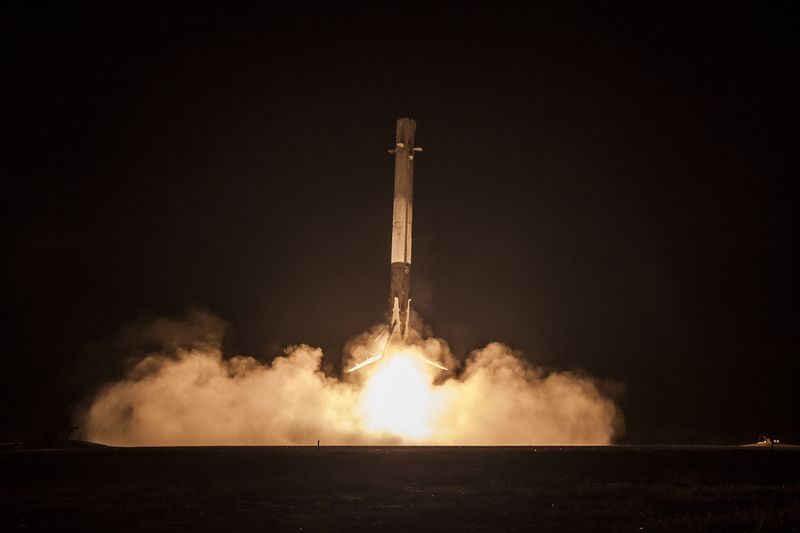SpaceX conducted fire tests of the return stage Falcon 9

The SpaceX company tried the Falcon 9 rocket in action. The stage bears the serial number F9-S1-0024, with its help, in May of this year, the JCSAT-14 communications satellite was launched into Earth's orbit. The first step on the return was planted on a platform in the Atlantic Ocean. She herself will not fly anywhere else, but you can carry out various tests and tests with her. Now the company has studied the operation of engines F9-S1-0024.
This is the second time this level has visited the company's test center in Texas. This is a McGregor test site. Delivered here are steps from their hangar in California. For the first time, a system with an escort was noticed on March 8, when the vehicle’s journey along the US 250 km long roads was completed. Usually SpaceX does not notify the public about the schedule of movement of its vehicles on the roads, but it is simply impossible not to notice all this.
After that, the F9-S1-0024 was photographed on the site ( L2 McGregor ). Here, experts conducted a series of tests, one of which was the inclusion of all nine Merlin 1D engines for the time that steps are usually required to bring the payload to the second stage into space. After that, the system was removed from the site and prepared for travel to Cape Canaveral, in the hangar.
')
Let me remind you that here she worked in May as part of the Falcon 9 launch vehicle. The Falcon 9 launch vehicle successfully launched from the launch site at Cape Canaveral, Florida, USA. The launch was made on May 6 at 8:21 Moscow time. Let me remind you that the rocket should launch a Japanese communications satellite JCSAT 14 weighing 5 tons into orbit 35405 km above the Earth’s surface, which was done.
As you know, the journey ended well, after which the engines of the stage earned again when landing on the automatic platform “Of Course I Still Love You”. Back in April, Ilon Mask said at one of the press conferences that the landing of the stage would most likely be unsuccessful, because the satellite had to be put into a very high orbit, and the fuel at the stage might not remain for landing. But everything worked out.

From the platform, the step was carefully removed, the landing “legs” were removed, and transferred to a horizontal position, placing it on a special conveyor. Step began its way to the hangar Pad 39A HIF. SpaceX stores all the steps here at Launch Complex 39A, Florida, USA. The company rents a launch complex from NASA. In a huge hangar 39A can simultaneously store up to 5 objects equal in size to the first stage of the Falcon 9 rocket. But with such a pace, the hangar can be filled in the next few months.
Already there, on the spot, it turned out that, due to the large starting loads and very high speed, the stage was badly damaged.

Testing stage F9-S1-0024 began on Thursday. By the way, on the same site, shortly before the JCSAT-14 was deployed, there was a step that would carry another communications satellite into space - JCSAT-16. This should happen next month. Engine operation lasted 2 minutes 30 seconds (the duration of the flight of the first stage). The data obtained from the analysis of the tests carried out will help the company to prepare one of the rest of the returned stages for the flight.
Preliminary data from the analysis of the stage with which the CRS-9 Dragon was sent to the ISS show that all systems are normal. According to Mask, the stage is in excellent condition. Perhaps it is used for re-flight into space.
Source: https://habr.com/ru/post/396373/
All Articles